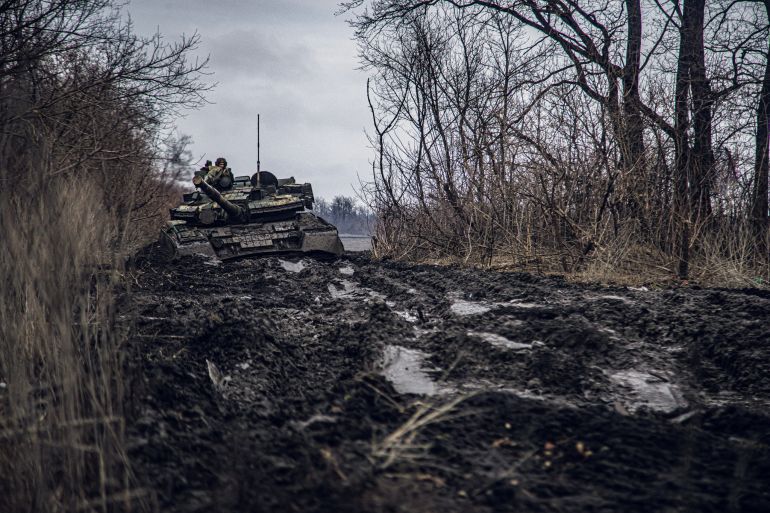Russian-backed separatists evacuate residents from east Ukraine
Leaders of self-proclaimed breakaway republics in eastern Ukraine announce plan to evacuate hundreds of thousands of residents to Russia.

Russian-backed separatists have packed civilians onto buses out of breakaway regions in eastern Ukraine, a stunning turn in a conflict the West believes Moscow plans to use as justification for all-out invasion of its neighbour.
Warning sirens blared in Donetsk after it and the other self-proclaimed “People’s Republic”, Luhansk, announced the evacuation of hundreds of thousands of people to Russia, with women, children and the elderly going first.
Keep reading
list of 4 itemsUK nixes ‘golden visas’ amid Russian money concerns
Ukraine and rebel region trade shelling allegations
Infographic: Russia, Ukraine and the global wheat supply
Without providing evidence, Denis Pushilin, the separatist leader in Donetsk, accused Ukraine of preparing to attack the two regions soon – an accusation Kyiv said was false.
“There are no orders to liberate our territories by force,” said Ukraine’s top security official, Oleksiy Danilov.
Millions of civilians are believed to live in the two rebel-held regions of eastern Ukraine; most are Russian speakers and many have already been granted Russian citizenship.
Within hours of the surprise announcement, families assembled to board buses at an evacuation point in Donetsk, where authorities said 700,000 people would leave.
Russian President Vladimir Putin ordered the government to house and feed people once they arrived in southern Russia, according to a Kremlin statement.
Renewed bombing
The evacuation began after the eastern Ukraine conflict zone saw intensified artillery bombardment on Friday, with the Kyiv government and the separatists trading blame.
Western countries have said they think the shelling, which began on Thursday and intensified on its second day, is part of Russian preparations to stage a pretext to invade its neighbour.
Russia has said it has no intention to attack Ukraine and accused the West of irresponsible fear-mongering.
Putin says situation deteriorating
A diplomatic source with years of direct experience of the conflict described shelling in eastern Ukraine as the most intense since major combat there ended with a 2015 ceasefire.
Close to 600 explosions were recorded on Friday morning, 100 more than on Thursday, some involving 152mm and 122mm artillery and large mortars, the source said. At least four rounds had been fired from tanks.
“They are shooting – everyone and everything,” said the source. “There’s been nothing like this since 2014-15.”
Other officials have disputed that characterisation, noting that there had been periods of deadly fighting during the ceasefire, and that there were no reports so far of deaths at the front line this week.
All eyes are on Putin’s next move as Moscow announced he will oversee a weekend drill of “strategic forces” – ballistic and cruise missiles.
“Right now we are seeing a deterioration of the situation,” Putin said at a news conference with his Belarus counterpart Alexander Lukashenko in Moscow.
Putin, who has demanded promises from the West that NATO will not expand eastwards, said the military drills held near Ukraine’s border in recent weeks – involving tens of thousands of soldiers – are not a threat.
“These exercises are purely defensive in nature and do not threaten anyone.”
He said the West and its allies are “not yet inclined to look seriously at these key security demands”.
Meanwhile, Ukraine’s Foreign Minister Dmytro Kuleba on Friday accused Russia of spreading disinformation that Kyiv planned to launch attacks in eastern Ukraine or sabotage chemical plans in the region.
“We categorically refute Russian disinformation reports on Ukraine’s alleged offensive operations or acts of sabotage … Ukraine does not conduct or plan any such actions in the Donbas [region],” he said on Twitter.
We categorically refute Russian disinformation reports on Ukraine’s alleged offensive operations or acts of sabotage in chemical production facilities. Ukraine does not conduct or plan any such actions in the Donbas. We are fully committed to diplomatic conflict resolution only.
— Dmytro Kuleba (@DmytroKuleba) February 18, 2022
Kuleba did not specify which reports he was referring to.
Russia said this week it had started withdrawing troops from the border near Ukraine.
But the United States said it had instead done the opposite: ramping up the force menacing its neighbour to between 169,000-190,000 troops, from 100,000 at the end of January.
“We see additional forces going to the border including leading edge forces that would be part of any aggression,” US Secretary of State Antony Blinken told the Munich Security Conference.
Western countries have said this week that Russian troops are making the sort of preparations normally seen in the final days before an attack, which could come within days.
“This is the most significant military mobilisation in Europe since the second world war,” US ambassador Michael Carpenter told a meeting at the Vienna-based Organization for Security and Cooperation in Europe.
Ukraine said Russia was planning staged attacks, including a faked video of a raid on a chemical plant, and falsely accusing it of provocations in the separatist areas.
“Ukrainian forces are not planning any offensive operations, and will not use weapons if this might threaten peaceful civilians,” the Ukrainian military said.